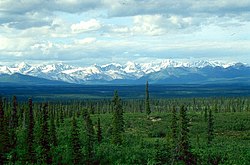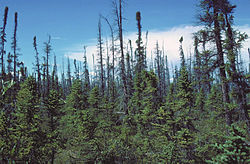This is an old revision of this page, as edited by 64.251.49.126 (talk) at 16:22, 27 April 2007 (→Soils). The present address (URL) is a permanent link to this revision, which may differ significantly from the current revision.
Revision as of 16:22, 27 April 2007 by 64.251.49.126 (talk) (→Soils)(diff) ← Previous revision | Latest revision (diff) | Newer revision → (diff)| This article includes a list of references, related reading, or external links, but its sources remain unclear because it lacks inline citations. Please help improve this article by introducing more precise citations. (Learn how and when to remove this message) |
| This article cites its sources but does not provide page references. You can help by providing page numbers for existing citations. (Learn how and when to remove this message) |

Taiga (IPA pronunciation: /ˈtaɪgə/ or /taɪˈga/, from Mongolian) is a biome characterized by coniferous forests. Covering most of inland Alaska, Canada, Sweden, Finland, inland Norway, northern Kazakhstan , Northern Europe and Russia (especially Siberia), as well as parts of the extreme northern continental United States, the taiga is the world's largest terrestrial biome. In Canada, boreal forest is the term used to refer to the southern part of this biome, while "taiga" is used to describe the more barren northern areas south of the Arctic tree-line.
Since North America and Eurasia were recently connected by the Bering land bridge, a number of animal and plant species (more animals than plants) were able to colonise both continents and are distributed throughout the taiga biome. Others differ regionally, typically with each genus having several distinct species, each occupying different regions of the taiga. Taigas also have some small-leaved deciduous trees like birch, alder, willow and aspen; mostly in areas escaping the most extreme winter cold. However, the deciduous Larch is coping with the coldest winters on the northern hemisphere in eastern Siberia. The southernmost part of the taiga also have trees like oak, maple and elm scattered among the conifers.
Climate and geography

The taiga biome has a harsh continental climate with a very large temperature range between summer and winter, classified as "Dfc" or "Dfb" in the Köppen climate classification scheme. Aside from the tundra and permanent ice caps, it is the coldest biome on Earth. High latitudes mean that, for much of the year the sun does not rise far above the horizon; winters last at least 5-6 months, with average temperatures below freezing. Temperatures vary from −50°C to 30°C throughout the whole year, with eight or more months of temperatures averaging below 10°C. The summers, while short, are generally warm and humid. In general, taiga grows north to the 10°C July isotherm, occasionally to the 9°C July isotherm. The southern limit is more variable, depending on rainfall; taiga may be replaced by open steppe woodland south of the 15°C July isotherm where rainfall is very low, but more typically extends south to the 18°C July isotherm, and locally where rainfall is higher (notably in eastern Siberia and adjacent northern Manchuria) south to the 20°C July isotherm. In these warmer areas, the taiga has higher species diversity with more warmth-loving species such as Korean Pine, Jezo Spruce and Manchurian Fir, and merges gradually into mixed temperate forest, or more locally (on the Pacific Ocean coasts of North America and Asia) into coniferous temperate rainforests.
The taiga experiences relatively low precipitation throughout the year (200–750 mm annually), primarily as rain during the summer months, but also as fog and snow; as evaporation is also low for most of the year, precipitation exceeds evaporation and is sufficient for dense vegetation growth. Snow may remain on the ground for as long as nine months in the northernmost extensions of the taiga ecozone.
Much of the area currently classified as taiga was recently glaciated. As the glaciers receded, they left depressions in the topography that have since filled with water, creating lakes and bogs (especially muskeg soil), found throughout the taiga.
Soils
Taiga soil tends to be young and nutrient-poor; it lacks the deep, organically-enriched profile present in temperate deciduous forests. The thinness of the soil is due largely to the cold; it hinders the development of soil, as well as the ease with which plants can use its nutrients. Fallen leaves and moss can remain on the forest floor for a long time in the cool, moist climate, which limits their organic contribution to the soil; acids from evergreen needles further leach the soil, creating spodosol. Since the soil is acidic due to the falling pine needles, the forest floor has only lichens and some mosses growing on it.hi
Flora

There are two major types of taiga, closed forest, consisting of many closely-spaced trees with mossy ground cover, and lichen woodland, with trees that are farther-spaced and lichen ground cover; the latter is more common in the northernmost taiga.
The forests of the taiga are largely coniferous, dominated by larch, spruce, fir, and pine. Evergreen species in the taiga (spruce, fir, and pine) have a number of adaptations specifically for survival in harsh taiga winters, though larch, the most cold-tolerant of all trees, is deciduous. Taiga trees tend to have shallow roots to take advantage of the thin soils, while many of them seasonally alter their biochemistry to make them more resistant to freezing, called "hardening". The narrow conical shape of northern conifers, and their downward-drooping limbs, also help them shed snow.
Because the sun is low in the horizon for most of the year, it is difficult for plants to generate energy from photosynthesis. Pine and spruce do not lose their leaves seasonally and are able to photosynthesize with their older leaves in late winter and spring when light is good but temperatures are still too low for new growth to commence. The adaptation of evergreen needles limits the water lost due to transpiration and their dark green color increases their absorption of sunlight. Although precipitation is not a limiting factor, the ground freezes during the winter months and plant roots are unable to absorb water, so desiccation can be a severe problem in late winter for evergreens.
Although the taiga is dominated by coniferous forests, some broadleaf trees also occur, notably birch, aspen, willow, and rowan. Many smaller herbaceous plants grow closer to the ground. Periodic stand-replacing wildfires (with return times of between 20-200 years) clear out the tree canopies, allowing sunlight to invigorate new growth on the forest floor. For some species, wildfires are a necessary part of the life cycle in the taiga; some, e.g. Jack Pine have cones which only open to release their seed after a fire, dispersing their seeds onto the newly cleared ground. Grasses grow wherever they can find a patch of sun, and mosses and lichens thrive on the damp ground and on the sides of tree trunks. In comparison with other biomes, however, the taiga has a low biological diversity.
Fauna
The taiga is home to a number of large herbivorous mammals and smaller rodents. These animals have also adapted to survive the harsh climate. Some of the larger mammals, such as bears, eat during the summer in order to gain weight and then go into hibernation during the winter. Other animals have adapted layers of fur or feathers to insulate them from the cold.
A number of wildlife species threatened or endangered with extinction can be found in the Canadian Boreal forest including woodland caribou, grizzly bear and wolverine. Habitat loss due to destructive development, mostly in the form of logging, is the main cause of decline for these species.
Due to the climate, carnivorous diets are an inefficient means of obtaining energy; energy is limited, and most energy is lost between trophic levels. However, predatory birds (owls and eagles) and other smaller carnivores, including foxes and weasels, feed on the rodents. Larger carnivores, such as lynxes and wolves, prey on the larger animals. Omnivores, such as bears and raccoons are fairly common, sometimes picking through human garbage.
A considerable number of birds such as Siberian Thrush, White-throated Sparrow and Black-throated Green Warbler, migrate to this habitat to take advantage of the long summer days and abundance of insects found around the numerous bogs and lakes. Of the perhaps 300 species of birds that summer in the taiga, only 30 stay for the winter. These are either carrion-feeding or large raptors that can take live mammal prey, including Golden Eagle, Rough-legged Buzzard, and Raven, or else seed-eating birds, including several species of grouse and crossbills.
Threats
Fire is the dominant natural disturbance in the taiga, as well as being an important disturbance mechanism in many other forest types, such as temperate, sub-alpine and chaparral forests. Large, stand-replacing fires, particularly in the taiga, determine the age distribution and spatial age mosaic of the forested landscape.
In Canada, less than 8% of the Boreal forest is protected from development and more than 50% has been allocated to logging companies for cutting . The main form of forestry in the Boreal forest in Canada is clearcutting, where most if not all trees are removed from an area of forest. Clearcut upwards of 11,000 hectares have been recorded in the Canadian Boreal forest. Some of the products from logged Boreal forests include toilet paper, copy paper, newsprint and lumber. More than 80% of Boreal forest products from Canada are exported for consumption and processing in the United States.
See also
- Boreal Forest Conservation Framework
- Success of fire suppression in northern forests
- Birds of North American boreal forests
Notes
- Arno & Hammerly 1984, Arno et al. 1995
- A.P. Sayre, Taiga, (New York: Twenty-First Century Books, 1994) 16.
- Sayre, 19.
- Sayre, 19.
- Sayre, 19-20.
- Sayre, 12-3.
- Sayre, 23.
- Sayre, 23.
- Sayre, 28.
- Global Forest Watch Canada 2000. Canada’s Forests At A Crossroads - An Assessment in the Year 2000
References
- Arno, S. F. & Hammerly, R. P. 1984. Timberline. Mountain and Arctic Forest Frontiers. The Mountaineers, Seattle. ISBN 0-89886-085-7
- Arno, S. F., Worral, J., & Carlson, C. E. (1995). Larix lyallii: Colonist of tree-line and talus sites. Pp. 72-78 in Schmidt, W. C. & McDonald, K. J., eds., Ecology and Management of Larix Forests: A Look Ahead. USDA Forest Service General Technical Report GTR-INT-319.
- Sayre, A. P. (1994). Taiga. New York: Twenty-First Century Books. ISBN 0-8050-2830-7
External links
- Threats to Boreal Forests (Greenpeace)
- Boreal Forests/Taiga (WWF)
- Arctic and Taiga (Canadian Geographic)
- Terraformers Canadian Taiga Conservation Foundation
- Coniferous Forest. Earth Observatory. NASA. .
- Taiga Rescue Network (TRN) A network of NGOs, indigenous peoples or individuals that works to protect the boreal forests.
- Index of Boreal Forests/Taiga ecoregions at bioimages.vanderbilt.edu
- The Nature Conservancy and its partners work to protect the Canadian Boreal Forest
- Slater museum of natural history: Taiga
Template:Terrestrial biomes Template:Ecozones ru-sib:Тайга
Categories: